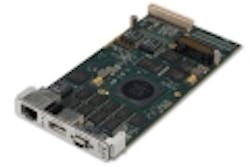Fast A/D converters for software-defined radio, radar processing, signals intelligence, and electronic warfare introduced by National Semiconductor
SANTA CLARA, Calif., 24 May 2010. National Semiconductor Corp. in Santa Clara, Calif., is introducing the ADC12D1800 3.6 giga-sample-per-second analog-to-digital converter for software-defined radio, radar processing, signals intelligence (SIGINT), and electronic warfare applications.
The A/D converter has dynamic performance of -147 dBm/Hz noise floor, 52 dB noise power ratio (NPR) and -61 dBFS intermodulation distortion (IMD) to enable a new generation of software-defined radio architectures and applications, National officials say.
In addition to the ADC12D1800, National introduced two other A/D converters: the ADC12D1600 with sampling speed as fast as 3.2 giga-samples per second and the ADC12D1000 with performance as fast as 2.0 giga-samples per second. All three PowerWise A/D converters are for software-defined radio and related applications like communications, multi-channel set-top box (STB), and light detecting and ranging (LIDAR) applications.
The A/D converter can help radio communications designers come up with new software-defined radio architectures due to the chip's ability to receive modulated, band-limited signals within a large bandwidth. In military radar systems, one ADC12D1X00 combined with a digital down-converter can replace several mixers, filters, amplifiers, and local oscillator stages in traditional heterodyne double- or triple-conversion radio implementations.
The latest class of software-defined radios requires the A/D converter to sample wide-bandwidth signals, so a new set of metrics such as noise-floor, NPR, and IMD provide the best measure of a system’s capability to extract narrowband information from a wideband spectrum, National officials say.
This is in stark contrast to traditional A/D converter specifications -- signal-to-noise ratio (SNR), spurious-free dynamic range (SFDR), and effective number of bits (ENOB) -- which focus on single-tone performance in the Nyquist bandwidth and do not provide the best gauge of a system’s overall capability.
National’s 12-bit A/D converters come in a leaded or lead-free, 292-ball, thermally enhanced BGA package, and are pin-compatible with the ADC10D1000 and ADC10D1500 A/D converters. The 12-bit A/D converters run off a 1.9-volt power supply and consist of two channels that can operate interleaved or as independent channels.
They include circuitry for multi-chip synchronization, programmable gain and offset adjustment per channel. The internal track-and-hold amplifier and extended self-calibration scheme enable a very flat response of all dynamic parameters for input frequencies exceeding 2 GHz, while providing an exceptionally low 10-18 code error rate.
A space-qualified version of the ADC12D1x00 will be supplied in a hermetic 376 column, ceramic column grid array (CCGA) package that meets radiation levels of 120 MeV for single event latch-up and a total ionizing dose of 100 Krads (Si). For more information contact National Semiconductor online at www.national.com.
